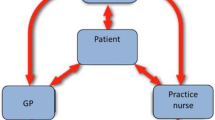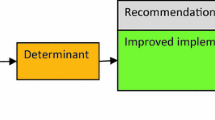Abstract
Purpose
Southcentral Foundation, an Alaska Native tribal health organization, has had a depression screening program in primary care since 2001. Program monitoring identified gaps in antidepressant refills and patients’ follow-up with behavioral health services. With extensive stakeholder participation, we developed an electronic, patient-centered, depression-management decision support tool (DM-DST). Quality of life and other outcomes are being assessed in a separate study; this case study reports on the multi-year stakeholder engagement process.
Methods
Data sources included interviews with patients and providers from integrated primary care teams, notes from research meetings, steering committee meetings, and consultations with tribal health system leadership, human subjects review committees, providers, and software designers, and a pilot test of the DS-DMT with patients and providers. We analyzed these sources using qualitative methods to assess the impact of stakeholder input on project processes and outcomes.
Results
One comprehensive, iPad-based tool was originally planned to facilitate discussions about depression management. Stakeholder input emphasized the role of family and cultural context of depression and management and improving the usability of the DM-DST. Stakeholder direction led us to split the DM-DST into: (1) a brief iPad-based tool to facilitate conversations between patients and providers during clinic visits; and (2) a complementary Web site that provides detailed information and allows patients flexibility and time to learn more about depression and share information and preferences with family and friends.
Conclusions
Stakeholder input across the project substantially modified the DM-DST to ensure cultural applicability to patients and providers and facilitate integration into clinics.



Similar content being viewed by others
References
Clinical and Translational Science Awards Consortium, Community Engagement Key Function Committee Task Force. (2011). Principles of community engagement (pp. 11–7782). Bethesda: NIH Publication no.
Tapp, H., & Dulin, M. (2010). The science of primary health-care improvement: Potential and use of community-based participatory research by practice-based research networks for translation of research into practice. Experimental Biology and Medicine, 235, 290–299.
Campinha-Bacote J. (2011). Delivering patient-centered care in the midst of a cultural conflict: The role of cultural competence. Online Journal of Issues in Nursing, 16(2), Manuscript 5.
Beach MC., Saha S., & Cooper LA. (2006). The role and relationship of cultural competence and patient-centeredness in health care quality. The Commonwealth Fund, Publication 960, http://www.commonwealthfund.org/~/media/files/publications/fund-report/2006/oct/the-role-and-relationship-of-cultural-competence-and-patient-centeredness-in-health-care-quality/beach_rolerelationshipcultcomppatient-cent_960-pdf.pdf. Accessed August 26, 2014.
Grundy, P., Hagan, K. R., Hansen, J. C., & Grumbach, K. (2010). The multi-stakeholder movement for primary care renewal and reform. Health Affairs (Millwood), 29, 791–798.
Gottlieb K. (2013). The Nuka System of Care: Improving health through ownership and relationships. International Journal of Circumpolar Health Aug 5: 72. doi: 10.3402/ijch.v72i0.21118.
Dillard, D. A., & Christopher, D. (2007). The Southcentral Foundation Depression Collaborative. International Journal of Circumpolar Health, 66, 45–53.
Kroenke, K., Spitzer, R. L., & Williams, J. B. (2001). The PHQ-9: Validity of a brief depression severity measure. Journal of General Internal Medicine, 16, 606–613.
Kroenke, K., Spitzer, R. L., Williams, J. B., & Lowe, B. (2010). The patient health questionnaire somatic, anxiety, and depressive symptom scales: A systematic review. General Hospital Psychiatry, 32, 345–359.
Gerring, J. (2004). What is a case study and what is it good for? American Political Science Review, 98, 341–354.
Yin R. K. (2009). Case study research: Design and methods. Thousand Oaks.
Begoray D. L., & Banister E. L. (2010). Reflexivity. In A. J. Mills, G. Durepos, & E. Wiebe (Ed.), Encyclopedia of Case Study Research. L-Z Index: Sage.
Carman, K. L., Dardess, P., Maurer, M., Sofaer, S., Adams, K., et al. (2013). Patient and family engagement: A framework for understanding the elements and developing interventions and policies. Health Affairs (Millwood), 32, 223–231.
Pinto R. M., Spector A., Rahman R., & Gastolomendo J. D. (2013). Research advisory board members’ contributions and expectations in the USA. Health Promotion International. [Epub ahead of print].
Elwyn, G., O’Connor, A. M., Bennett, C., Newcombe, R. G., Politi, M., et al. (2009). Assessing the quality of decision support technologies using the International Patient Decision Aid Standards instrument (IPDASi). PLoS One, 4, e4705.
O’Connor A.M., Bennett C. L., Stacey D., Barry M., Col N. F., et al. (2009). Decision aids for people facing health treatment or screening decisions. Cochrane Database System Review: CD001431.
Legare, F., Turcotte, S., Stacey, D., Ratte, S., Kryworuchko, J., et al. (2012). Patients’ perceptions of sharing in decisions: A systematic review of interventions to enhance shared decision making in routine clinical practice. Patient, 5, 1–19.
Sepucha, K. R., Borkhoff, C. M., Lally, J., Levin, C. A., Matlock, D. D., et al. (2013). Establishing the effectiveness of patient decision aids: Key constructs and measurement instruments. BMC Medical Informatics and Decision Making, 13(Suppl 2), S12.
Stacey, D., Kryworuchko, J., Belkora, J., Davison, B. J., Durand, M. A., et al. (2013). Coaching and guidance with patient decision aids: A review of theoretical and empirical evidence. BMC Medical Informatics and Decision Making, 13(Suppl 2), S11.
Gottlieb, K., Sylvester, I., & Eby, D. (2008). Transforming your practice: What matters most. Family Practice Management, 15, 32–38.
Johnson, C., Gunn, J., & Kokanovic, R. (2009). Depression recovery from the primary care patient’s perspective: ‘Hear it in my voice and see it in my eyes’. Mental Health in Family Medicine, 6, 49–55.
Raue, P. J., Schulberg, H. C., Lewis-Fernandez, R., Boutin-Foster, C., Hoffman, A. S., et al. (2010). Shared decision-making in the primary care treatment of late-life major depression: A needed new intervention? International Journal of Geriatric Psychiatry, 25, 1101–1111.
Barratt, A. (2008). Evidence based medicine and shared decision making: the challenge of getting both evidence and preferences into health care. Patient Education and Counseling, 73, 407–412.
Barry, M. J. (2012). Shared decision making: informing and involving patients to do the right thing in health care. The Journal of Ambulatory Care Management, 35, 90–98.
Acknowledgment
This work was supported by a grant from the Patient-Centered Outcomes Research Institute, Renee Robinson, PI.
Author information
Authors and Affiliations
Corresponding author
Rights and permissions
About this article
Cite this article
Starks, H., Shaw, J.L., Hiratsuka, V. et al. Engaging stakeholders to develop a depression management decision support tool in a tribal health system. Qual Life Res 24, 1097–1105 (2015). https://doi.org/10.1007/s11136-014-0810-9
Accepted:
Published:
Issue Date:
DOI: https://doi.org/10.1007/s11136-014-0810-9




